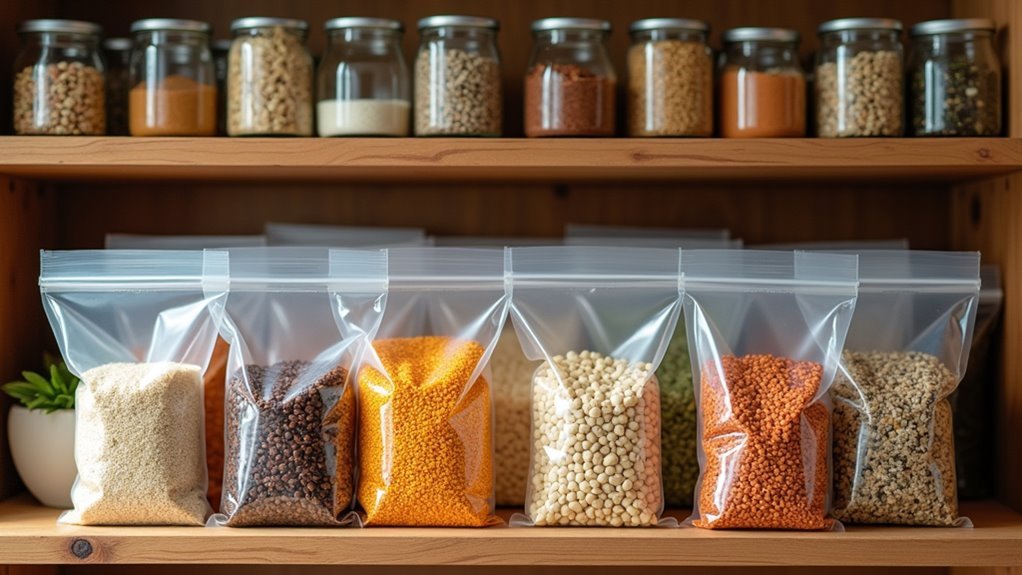For successful long-term dry goods storage, we recommend using a high-quality vacuum sealer like NutriChef to extend freshness up to five times longer. Pre-measure items into practical portions, use brown paper bags for powdery substances to prevent clogs, and implement a clear labeling system with dates. Always make sure items are completely dry before sealing, and leave extra bag length for secure seals. These simple techniques will transform your food preservation strategy for years to come.
Essential Equipment for Vacuum Sealing Success

When starting on your vacuum sealing journey, you'll need to gather the right tools to guarantee your food stays fresh for the long haul.
We've found that investing in a high-quality vacuum sealer is absolutely essential—it creates the airtight seal that keeps moisture and air away from your precious dry goods. NutriChef vacuum sealers offer effective food preservation by extending the freshness of food up to five times longer than traditional methods.
Don't forget to stock up on vacuum bags in various sizes!
We love having both roll bags for custom lengths and pre-made pouches for quick sealing jobs. For fine items like flour or potato flakes, we recommend using brown paper bags inside your vacuum pouches to prevent clogging your sealer.
A reliable food scale is another must-have essential equipment item.
It'll help you portion accurately, manage your inventory better, and make certain consistent serving sizes.
Finally, keep labels handy to mark contents and dates!
Preventing Vacuum Sealer Clogs With Dry Goods
Although vacuum sealers are incredible tools, they're often susceptible to clogs when working with dry goods like flour, sugar, or spices.
We've found that preventing vacuum sealer clogs with dry goods is simple once you know the right techniques!
For best results, follow these practical steps:
- Use brown paper bags or specialized barrier bags that absorb powders
- Pre-measure dry goods into smaller portions to prevent overfilling
- Keep the bag opening clean by using funnels when filling
- Allow extra bag length when using roll bags for a more effective seal
Don't forget to clean your sealer's nozzle and filter regularly according to manufacturer's guidelines. Additionally, ensure that you use compatible vacuum sealer bags to avoid any issues during the sealing process.
With these tips, you'll extend your machine's life while ensuring your pantry staples stay fresh for months to come!
Portioning Strategies for Maximum Efficiency

Smart portioning strategies aren't just about preventing clogs—they're the secret to maximizing your vacuum sealing efficiency! When we pre-portion dry goods into quarter-cup increments, we're actually setting ourselves up for hassle-free meal prep while minimizing waste.
We've found that portioning before sealing makes everyday cooking simpler and gives us perfect control over our ingredients. Additionally, this method helps maintain the freshness and flavor of dry foods by minimizing air exposure during storage.
Don't forget to leave extra length in your roll bags to guarantee a tight, secure seal. This approach protects against moisture and air exposure, extending shelf life considerably.
An added bonus? Well-portioned supplies make bartering and sharing with neighbors much easier during challenging times.
Always label each package with the contents and date—your future self will thank you when you're searching through your beautifully organized pantry!
Labeling Systems for Organized Storage
Thoughtful labeling systems transform vacuum-sealed storage from merely functional to brilliantly organized!
We've found that proper labeling makes all the difference when you're searching for specific ingredients during meal prep or emergencies. Clear, waterproof labels guarantee your information stays legible even in moisture-prone pantry environments.
For a truly efficient labeling system, we recommend:
- Implementing color-coding to quickly identify different food categories
- Including both the product name and sealing date to track freshness
- Using a labeling tool or printer for consistent, easy-to-read text
- Reviewing and updating your system quarterly to prevent confusion
Vacuum sealing extends food shelf life significantly, allowing you to maintain a well-organized inventory.
Don't underestimate how much time you'll save with well-labeled storage!
Best Practices for Different Dry Goods Categories

For powdery items like flour and potato flakes, we've found that brown paper bags are lifesavers. They prevent those fine particles from clogging your vacuum sealer while helping extend the shelf life of these staples. Remember to think about portion sizes too! Measuring out quarter-cup servings of potato flakes or two-cup portions of flour makes future meal preparation so much simpler. When using roll bags, always leave extra material at the top for a proper seal. Don't forget to label everything with names and dates! This small step guarantees you'll use older items first and can quickly identify what's in each package—especially helpful during emergencies when organization matters most. Additionally, ensure that items are completely dry before sealing to prevent mold and mildew growth, which can compromise your stored goods.
Creative Uses for Vacuum-Sealed Packages
Vacuum-sealing isn't just for keeping pantry items fresh—it's a versatile tool for everyday challenges. Make sure you consider these innovative applications:
- Emergency preparedness - Create family survival kits with portioned meals that provide quick access during unexpected situations.
- Bartering resource - Pre-portioned, clearly labeled goods can facilitate efficient exchanges during crisis situations.
- Gift baskets for those in need - Easily stackable, transportable packages that maintain freshness.
- Space-saving travel solution - Compress clothing and non-food items to reduce luggage weight and maximize space.
When meal prepping, vacuum-sealed portions help prevent food waste by allowing you to defrost only what you need—saving money and resources! Additionally, vacuum sealing significantly reduces food waste, which is especially beneficial for bulk buyers looking to optimize their storage solutions.
Frequently Asked Questions
Is Vacuum Sealing Good for Long Term Storage?
We've found vacuum sealing excellent for long-term storage. It dramatically extends shelf life by removing air that causes deterioration. We'd recommend it for preserving your dry goods for years.
What Is the Best Way to Store Dry Goods Long Term?
Time flies while our food expires! We've found vacuum sealing dry goods in airtight storage containers is best for long-term preservation, especially when properly labeled and stored in cool, dark places.
How Long Will Vacuum Sealed Dry Goods Last?
We've found vacuum sealed dry goods can extend shelf life dramatically. They'll last 1-2 years typically, but freeze-dried items can remain good for 5-10 years when stored properly in cool, dark places.
Should You Vacuum Seal Dry Goods?
While bare pantries worry us, full ones comfort. We'd absolutely recommend vacuum sealing dry goods! It's what we do for moisture control and dramatically extended shelf life—often years beyond normal storage methods.
Can You Vacuum Seal Flour for Long Term Storage?
Yes, we can vacuum seal flour for long-term storage. It's an excellent flour preservation method that extends shelf life to 1-2 years by protecting against air, moisture, and pests.
